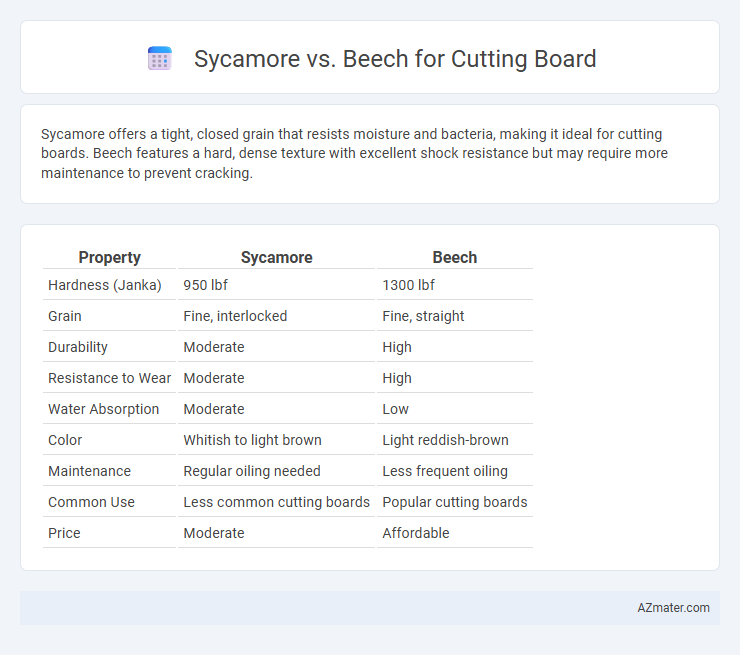Sycamore offers a tight, closed grain that resists moisture and bacteria, making it ideal for cutting boards. Beech features a hard, dense texture with excellent shock resistance but may require more maintenance to prevent cracking.
Table of Comparison
| Property | Sycamore | Beech |
|---|---|---|
| Hardness (Janka) | 950 lbf | 1300 lbf |
| Grain | Fine, interlocked | Fine, straight |
| Durability | Moderate | High |
| Resistance to Wear | Moderate | High |
| Water Absorption | Moderate | Low |
| Color | Whitish to light brown | Light reddish-brown |
| Maintenance | Regular oiling needed | Less frequent oiling |
| Common Use | Less common cutting boards | Popular cutting boards |
| Price | Moderate | Affordable |
Introduction to Sycamore and Beech Wood
Sycamore wood, known for its fine grain and light color, offers excellent durability and resistance to cutting marks, making it a popular choice for cutting boards. Beech wood features a tight, straight grain and a slightly harder surface, providing a smooth, knife-friendly cutting experience with natural antibacterial properties. Both woods are hardwoods prized for their longevity and ability to maintain food safety standards in kitchen use.
Wood Grain and Appearance Comparison
Sycamore cutting boards feature a fine, uniform grain with subtle, wavy patterns that provide a smooth surface and light, creamy color with occasional darker streaks. Beech cutting boards showcase a tighter, more consistent grain with a pinkish hue, offering a warm and classic appearance that resists knife marks effectively. Both woods are dense and durable, but Sycamore's lighter tone contrasts sharply with Beech's richer, reddish finish, influencing the choice based on kitchen aesthetic preferences.
Hardness and Durability Differences
Sycamore wood has a Janka hardness rating of around 950, making it moderately hard but less dense compared to Beech, which scores approximately 1,300 on the Janka scale, indicating superior hardness. This higher density of Beech translates to greater resistance against knife marks and wear, enhancing durability for cutting boards subjected to frequent use. While Sycamore offers a smooth surface and aesthetic appeal, Beech's toughness ensures longer-lasting performance and better protection against dents and gouges in kitchen environments.
Food Safety and Hygiene Considerations
Sycamore wood is less dense and more porous than beech, making it more prone to absorbing moisture and harboring bacteria, which can affect food safety on cutting boards. Beech wood's tight grain structure offers greater resistance to knife marks and bacterial penetration, enhancing hygiene during food preparation. Both woods have natural antimicrobial properties, but beech's durability and lower porosity make it a superior choice for maintaining clean, safe cutting surfaces.
Maintenance and Care Requirements
Sycamore cutting boards require regular oiling to prevent drying and cracking, with occasional sanding to maintain a smooth surface. Beech boards are more resistant to moisture and warping but still benefit from frequent conditioning with food-safe mineral oil to preserve durability. Both hardwoods should be hand-washed and promptly dried to avoid damage and prolong lifespan.
Workability for Cutting Board Crafting
Sycamore offers excellent workability for cutting board crafting due to its fine, even grain and moderate hardness, making it easy to shape and sand without compromising durability. Beech, known for its tight grain and hardness, provides a stable and smooth surface but requires more effort in machining and finishing compared to sycamore. Both woods resist knife marks well, yet sycamore's slightly softer nature allows for easier customization and finishing in cutting board production.
Resistance to Moisture and Warping
Sycamore cutting boards offer moderate resistance to moisture due to their tight end-grain structure, but they can warp if not properly maintained or sealed. Beech wood, characterized by its dense, fine grain, provides superior resistance to moisture absorption and warping, making it a more durable choice for cutting boards exposed to frequent wet conditions. The natural hardness and stability of beech contribute to its longevity and ability to withstand daily kitchen use without significant deformation.
Price and Availability in the Market
Sycamore cutting boards generally offer a more affordable price point due to the wood's widespread availability and faster growth rate. Beech, while reasonably priced, tends to be slightly more expensive because of its durability and denser grain, which are highly valued in kitchen tools. Both woods are readily available in most markets, but sycamore may appear more frequently in budget-friendly options, making it a popular choice for cost-conscious buyers.
Eco-Friendliness and Sustainability
Sycamore and beech wood both offer eco-friendly qualities for cutting boards, with sycamore sourced from fast-growing trees that contribute to quicker forest regeneration. Beech, often harvested from sustainably managed European forests, is known for its durability and resistance to bacteria, reducing waste over time due to its longevity. Choosing either wood supports sustainable practices when sourced responsibly, but sycamore's rapid growth rate slightly enhances its sustainability profile by minimizing environmental impact.
Pros and Cons: Sycamore vs Beech
Sycamore cutting boards offer a dense, fine-grain surface that resists knife marks and provides natural antibacterial properties, making them highly durable and hygienic; however, they tend to be more expensive and can warp if not properly maintained. Beech cutting boards feature a tight grain that is hard and wear-resistant, offering a stable and affordable option with moderate resistance to moisture damage but may dull knives faster due to its harder surface. While sycamore excels in long-term durability and smooth texture, beech is favored for its cost-effectiveness and ease of maintenance, but both require regular oiling to prevent cracking and ensure longevity.

Infographic: Sycamore vs Beech for Cutting Board
 azmater.com
azmater.com